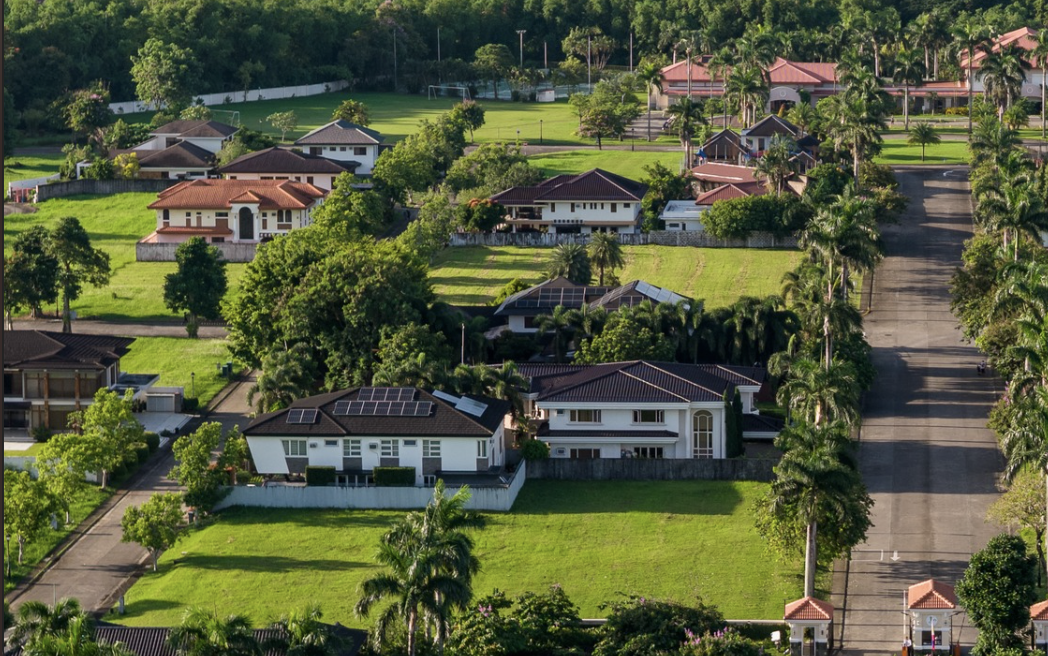Electricity costs in Negros Occidental continue to impact household budgets significantly. Negros Power, which serves Bacolod, Talisay, Silay, Bago, Murcia, and Don Salvador Benedicto, reported rates of ₱11.48 per kilowatt-hour in March 2025, down from ₱12.15 per kWh the previous month. For the average family consuming 500 kWh monthly, this translates to ₱5,700-6,100 in electricity bills.
The trend shows monthly rate volatility influenced by generation costs, transmission charges, and wholesale electricity market prices. September 2025 saw rates spike to ₱12.44 per kWh in nearby Iloilo under MORE Power’s service area, demonstrating the unpredictability of grid electricity costs. Over 25 years, assuming a conservative 3% annual increase, a family currently paying ₱6,000 monthly will spend approximately ₱2.66 million on electricity alone. So lets Residential Solar Cost vs. MORE Power in Negros Occidental.
Solar Panel Adoption in Premium Negros Subdivisions
The response from homeowners in Negros Occidental’s premium subdivisions tells an interesting story. In developments like Ayala North Point—a 215-hectare estate with over 2,145 residential lots in Talisay—an increasing number of rooftops now feature solar panel installations. Similarly, communities like Verdana Homes within the Plantazionne development, The Enclaves, and Town and Country show growing solar adoption.
These subdivisions share characteristics that make solar particularly attractive: modern homes with strong roof structures, unobstructed sun exposure, high electricity consumption from air conditioning and appliances, and residents with long-term ownership plans. The visibility of successful installations creates a ripple effect, with neighbors observing real savings and following suit.
The Real Cost Comparison
A typical 5 kW solar system suitable for an average family home costs ₱250,000-300,000 for complete turnkey installation. This includes premium solar panels with 25-30 year warranties, grid-tied inverters, typhoon-rated mounting systems, all permits and electrical work, Negros Power net metering coordination, and professional installation.
For a family currently spending ₱6,000 monthly on Negros Power electricity, this 5 kW system generates approximately 600 kWh per month. Through Negros Power’s net metering program, excess daytime generation is exported to the grid for peso-for-peso credits, which offset nighttime consumption. The result: monthly bills typically drop to ₱800-1,200 in basic charges only, creating monthly savings of ₱4,800-5,200.
The payback calculation is straightforward. With ₱60,000 in annual savings, a ₱280,000 investment pays for itself in 4.7 years. After payback, homeowners enjoy 20+ additional years of minimal electricity costs—the panels continue generating power for 25-30 years with only basic maintenance requirements.
Understanding Net Metering with Negros Power
Net metering makes solar financially viable for Negros Occidental residents. During sunny hours, panels typically generate more electricity than the home consumes. This excess flows back to Negros Power’s grid, earning credits that offset evening and nighttime consumption when panels aren’t producing. Without net metering, excess generation would be wasted, reducing savings by 30-40%. With it, homeowners achieve 80-95% bill reduction.
The system requires approved permits, Negros Power interconnection approval, and bi-directional meter installation—all of which reputable solar installers handle as part of their service. The process typically takes 8-12 weeks from contract signing to system activation.
Long-Term Financial Impact
The 25-year comparison reveals the true value proposition. Staying with Negros Power exclusively costs the average family ₱2.66 million over 25 years, assuming modest rate increases. This represents pure expense with no asset value and exposure to ongoing rate volatility.
Installing solar requires a ₱280,000-300,000 initial investment plus approximately ₱240,000-360,000 in remaining Negros Power basic charges and ₱50,000-75,000 in minor maintenance over 25 years. Total 25-year cost: ₱590,000-735,000. The difference—₱1.93 million to ₱2.07 million in net savings—represents money that stays in homeowners’ pockets instead of going to utility bills.
Larger homes see even more dramatic savings. An 8 kW system costing ₱450,000 for homes with ₱10,000 monthly bills delivers net savings exceeding ₱3 million over 25 years.
Weather and Maintenance Considerations
Concerns about typhoons and rainy weather are valid in Negros Occidental. Quality solar installations use typhoon-rated mounting designed for 200+ kph winds. Panels are typically more secure than roof tiles when properly installed. Including the solar system in home insurance provides additional protection at minimal cost.
During rainy season, generation drops to 10-25% of normal on cloudy days. However, annual performance remains predictable because dry season excess balances rainy season reduction. Net metering credits accumulated during high-generation months help during low-production periods.
Maintenance requirements are minimal: panel cleaning 2-4 times yearly, quarterly visual inspections, and annual professional checkups cost ₱2,000-5,000 annually—negligible compared to savings.
Summary
The financial case for residential solar in Negros Occidental is compelling. MORE rates show monthly volatility, with recent fluctuations ranging from ₱11.48 to ₱12.15 per kWh, making grid-only power increasingly unpredictable. Meanwhile, solar technology has matured, costs have decreased, and net metering programs enable maximum savings.
For homeowners in developments like Ayala North Point, Verdana, The Enclaves, and Town and Country—all within Negros Power’s franchise area covering Bacolod, Talisay, Silay, Bago, Murcia, and Don Salvador Benedicto—the combination of high electricity consumption, excellent sun exposure, modern infrastructure, and long-term residence plans creates ideal conditions for solar adoption. With 4-5 year payback periods and ₱1.8-3 million in lifetime savings, solar panels represent one of the most financially sound home improvements available to Negros Occidental residents today.


Leave a Reply